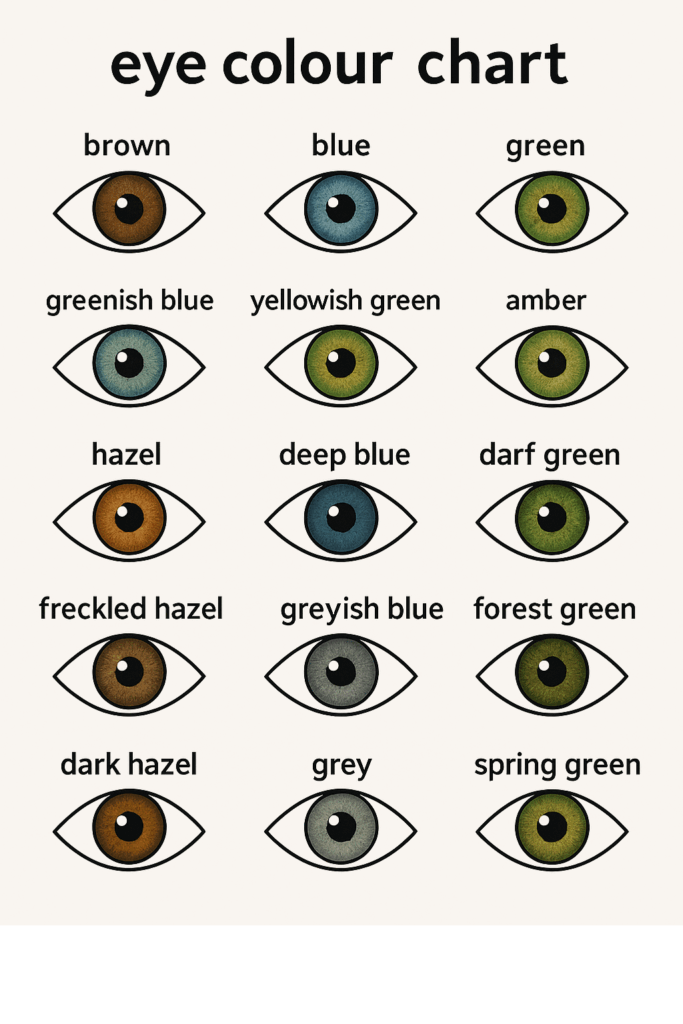Eye Color Test online – Discover Your Eye Shade with the Eye Color Chart
Eye color is one of the most fascinating human traits, ranging from common shades like brown and blue to rare tones such as amber, grey, or even green. With our interactive Eye Color Test, you can quickly discover your exact iris shade and see where it fits within the natural eye color chart. Everything runs directly in your browser – fully private, no uploads required. Beyond identifying your color, you’ll also gain insights into the genetics, pigmentation, and unique characteristics that make every eye color special. Try the tool now and explore the spectrum of natural and rare eye colors.
📊 Eye Color Chart – Distribution, Genetics & Traits
| Eye Color | Global Distribution | Genetic / Pigment Factors | Special Traits & Notes |
|---|---|---|---|
| Brown | 55–79% (most common) | High levels of eumelanin in iris | Strong UV protection, dominant worldwide (Africa, South America, Asia) |
| Black | 10–15% (true black <1%) | Extremely high eumelanin or aniridia (undeveloped iris) | Appears almost fully dark; true black eyes are very rare |
| Blue | 8–10% | Very low melanin, Rayleigh scattering in stroma | Originated from one mutation ~6–10k years ago in Europe |
| Green | 2–3% | Moderate melanin + lipochrome + scattering | Rarest common shade; prevalent in Celtic & Northern European ancestry |
| Hazel | 5–8% | Mixed melanin + lipochrome → multicolored iris | Dynamic shade that shifts between brown, green & amber depending on light |
| Amber | <5% | High lipochrome, little eumelanin | Golden/copper tone, also called “wolf eyes” |
| Grey | ~1% | Very low melanin + high collagen scattering | Smoky/silvery look, eye color may shift with lighting |
| Violet | Extremely rare | Very low melanin + reflection of blood vessels (often in albinism) | Famous in Elizabeth Taylor’s unique iris scattering |
| Red | Extremely rare | Albinism → complete lack of melanin | Blood vessels visible, often linked with vision problems & light sensitivity |
| Heterochromia | <1% | Uneven melanin distribution; genetic or from injury/disease | Eyes of two different colors, or multi-colored segments in one iris |
| Special Shades (Deep Blue, Dark Hazel, Leaf Green, Forest Green, Spring Green etc.) | Rare (<1–2%) | Variations of melanin/lipochrome levels + scattering | Often regional or individual variations, not separate gene types |
Discover the Science Behind Eye Colors with Our Eye Color Test
Eye color is more than just a visual trait – it’s a reflection of our unique genetic code and human diversity. By using the Eye Color Test, you can quickly determine your iris shade and see how it fits into the broader eye color chart that ranges from common hues like brown and blue to rare shades such as amber, grey, or even violet.
At the core of eye color formation lies melanin, the natural pigment that defines not only eye color but also skin and hair. Higher concentrations of eumelanin create brown and black eyes, while lower amounts allow Rayleigh scattering to produce blue tones. A balance of melanin and lipochrome results in the green and hazel shades that are admired for their rarity.
Globally, brown eyes dominate with up to 79% prevalence, while green eyes are found in only 2–3% of people. Grey, amber, red, and violet are considered the rarest and often linked to specific genetic variations. Understanding this spectrum helps reveal fascinating insights into ancestry, evolution, and even medical conditions such as albinism or heterochromia.
Our interactive tool makes discovering your true eye shade simple, private, and instant. Whether you’re curious about your own color, studying eye color genetics, or exploring the diversity of human appearance, this test provides both clarity and connection to the science behind one of humanity’s most captivating traits.


